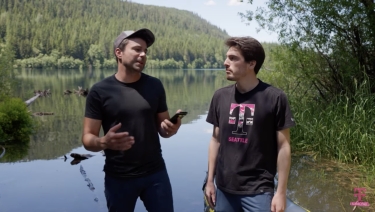T-Mobile has opened registration for a beta program for T-Mobile Starlink, a direct-to-mobile satellite service designed to help eliminate dead zones by providing coverage for the 500,000 square miles of land in the US not covered by ground based towers.
All T-Mobile customers - including businesses and first responders - can register for access to the beta launch.
Eliminating dead zones with mobile towers in space, in the form of communications satellites, is becoming a reality as Starlink, continues to expand its LEO network with the launch of direct-to-mobile satellites into orbit.
“T-Mobile Starlink is the first major low-earth orbit constellation in the world paired with terrestrial cellular spectrum, making the phone in your pocket work in areas of the U.S. that have never, and probably never will, have ground based coverage,” said Mike Katz, President of Marketing, Strategy and Products, T-Mobile.
“It’s a truly groundbreaking engineering breakthrough and means that we are one step closer to helping T-Mobile customers have confidence that, no matter where they are, if they can see the sky, they will be covered by T-Mobile.”
T-Mobile says that initially T-Mobile Starlink will support texting only, with voice and data coming in the future.
First responder agencies and individuals will be prioritised by T-Mobile for the beta program.
|
|
"With Starlink’s direct-to-cell satellite constellation specifically designed for integration with the T-Mobile terrestrial network, the experience is expected to be much more user friendly than other satellite messaging services currently in market," T-Mobile said in its announcement.
"For example, users will not need to hold their phone up to search for a signal.
"Both inbound and outbound messages are sent and received just like any other message."
T-Mobile’s vision is to deliver the best service practically everywhere in the continental US, Hawaii, parts of Alaska, Puerto Rico and territorial waters, even outside the signal of T-Mobile’s terrestrial cellular network.\
T-Mobile Starlink was turned on temporarily to provide a critical communication option for those without any other means to reach emergency responders and loved ones during Hurricanes Helene and Milton.
According to T-Mobile even without the full Starlink constellation in place, customers with capable devices were able to receive critical emergency alerts and send and receive messages when satellites were overhead.
When fully deployed,T-Mobile and Starlink anticipate having the ability to cover well over half a million square miles across the US and ocean expanses that can’t be reached by land-based towers. By expanding connectivity to these remote areas, the companies are working to say goodbye to mobile dead zones and the need for costly satellite phones — allowing Un-carrier customers to stay connected almost anywhere they go.
So far, KDDI (Japan), Optus (Australia), One NZ (New Zealand), Salt (Switzerland), Entel (Chile & Peru) and Rogers (Canada) are among the providers that have signed on to launch direct to cell technology.









































